

“Portraits of the Passion:
The Descent from the Cross”
Matthew 27:45-66
Pastor Kevin Vogts
Trinity Lutheran Church
Paola, Kansas
Lent Service VI—April 1, 2020
Grace to you and peace from God our Father and the Lord
Jesus Christ. Amen.
This evening we conclude our Lenten sermon series “Portraits of the
Passion,” the Lenten story illustrated with slides of artworks from the
Nelson-Atkins Museum and the Spencer Museum of Art at the University of Kansas.
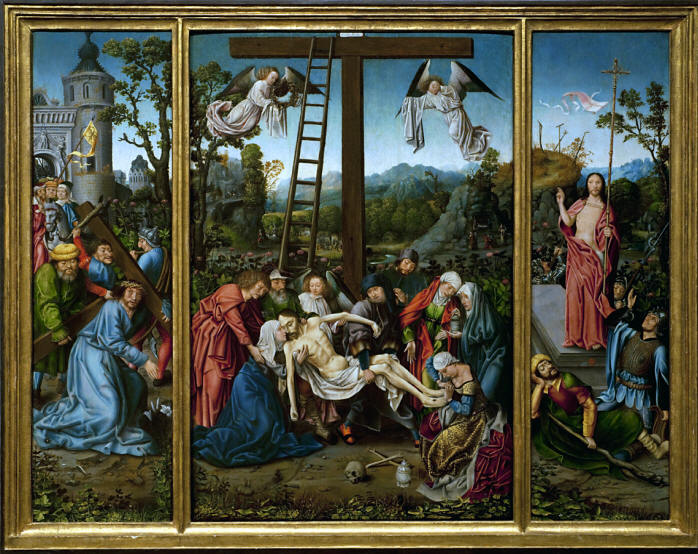
“Descent from the Cross”
Triptych
Workshop of the Master of Frankfurt – 1500’s – Oil on Oak Panels
An extremely popular genre in Christian art in the Middle Ages and
Renaissance was the “The Descent from the Cross,” as seen in this German
triptych from the 1500’s. A triptych is a three-paneled painting, usually
for display above an altar. “The Descent from the Cross” illustrates
Paul’s words in Acts, “Though they found no proper ground for a death sentence,
they asked Pilate to have him executed. When they had carried out all that
was written about him, they took him down from the cross and laid him in a
tomb.”
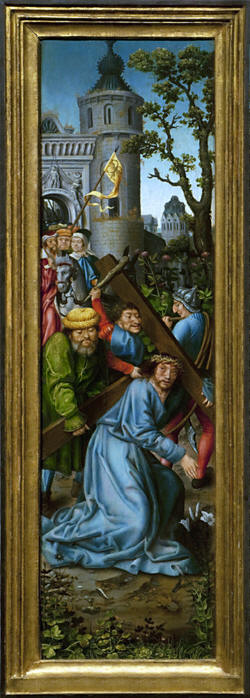
Detail from “Descent from the Cross”
Triptych
Workshop of the Master of Frankfurt – 1500’s – Oil on Oak Panels
The first panel of this triptych shows Christ being paraded out to be
crucified, carrying his own cross to Calvary. John says, “Pilate handed
Jesus over to them to be crucified. So the soldiers took charge of him.
Carrying his own cross, he went out to the place of the Skull, which in Aramaic
is called Golgotha. There they crucified him.”
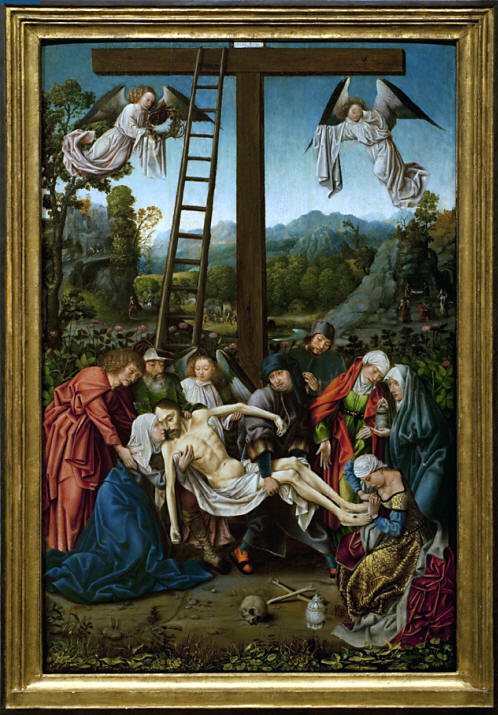
Detail from “Descent from the Cross”
Triptych
Workshop of the Master of Frankfurt – 1500’s – Oil on Oak Panels
The center panel shows the scene at Mt. Calvary after Christ’s death,
as his body is lowered from the cross for entombment. As the Gospels
report, “As evening approached, there came a rich man from Arimathea, named
Joseph, who had himself become a disciple of Jesus. Going to Pilate, he
asked for Jesus’ body, and Pilate ordered that it be given to him. . . He
was accompanied by Nicodemus, the man who earlier had visited Jesus at night.
Nicodemus brought a mixture of myrrh and aloes, about seventy-five pounds. . .
So Joseph bought some linen cloth, took down the body and . . . the two of them
wrapped it, with the spices, in strips of linen. This was in accordance with
Jewish burial customs. . . and placed it in Joseph’s own new tomb that he
had cut out of the rock. He rolled a big stone in front of the entrance to the
tomb.”
The Gospels also report, “The women who had come with Jesus from
Galilee followed Joseph and saw the tomb and how his body was laid in it.”
This is represented by the group of women gathered around as their beloved Jesus
is lowered from the cross.
Two angels are portrayed bearing the linens with which Christ’s body
will be wrapped. One angel holds Christ’s crown of thorns. The other angel
hides his face, not bearing to look at the horrible sight of the Lord of Life’s
mutilated, battered, lifeless body. As Isaiah says, “His appearance was so
disfigured beyond that of any man and his form marred beyond human likeness. . .
Like one from whom men hide their faces.”
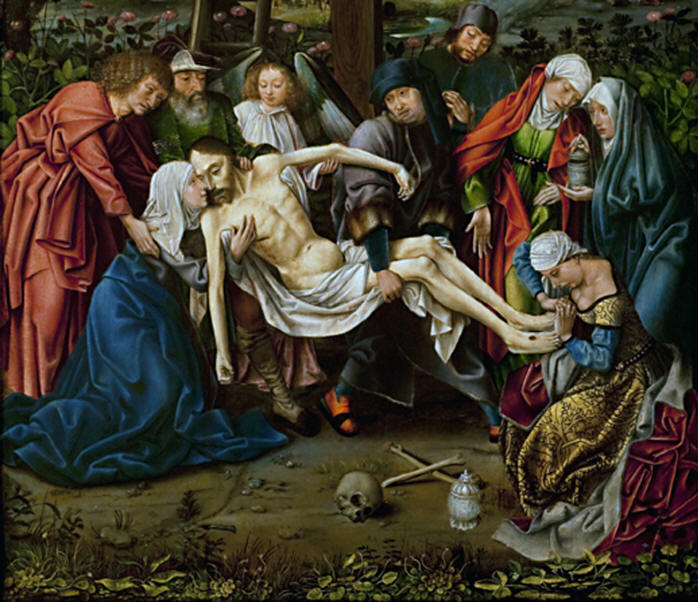
Detail from “Descent from the Cross”
Triptych
Workshop of the Master of Frankfurt – 1500’s – Oil on Oak Panels
The Gospels tell us that Jesus’ mother Mary was near the cross as Jesus
was crucified, and in this detail Jesus’ mother Mary mournfully cradles her
Son’s lifeless body. This scene developed into its own very popular genre,
that we considered last week, called the Pieta, the Latin word for “pity.”
We also see in this detail the wounds of Christ: his hands and feet, as Peter
says in Acts, “You put him to death by nailing him to the cross.” And his
side, as John reports, “One of the soldiers pierced his side with a spear,
bringing a sudden flow of blood and water.” Another angel in the background
poignantly helps bear the lifeless body of the Son of God.
Earlier that week, Mary, the sister of Lazarus, had anointed Jesus with
perfume, and Jesus had said, “She anointed my body with perfume beforehand to
prepare for my burial. I tell you the truth, wherever the Gospel is
preached throughout the world, what she has done will also be told, in memory of
her.” And so, in this detail that incident is telescoped forward and
included in the scene at the cross, showing Mary lovingly anointing Jesus’ body
for burial.
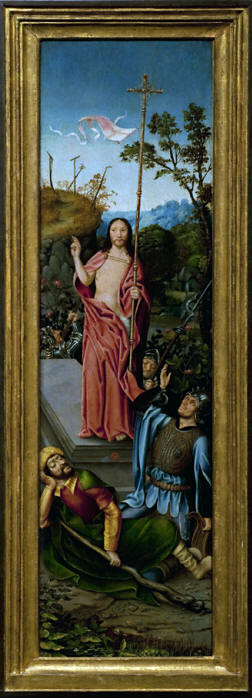
Detail from “Descent from the Cross”
Triptych
Workshop of the Master of Frankfurt – 1500’s – Oil on Oak Panels
The third panel of the triptych shows Christ’s triumphant resurrection.
Around him are the soldiers who were guarding his tomb. Christ stands
dramatically on top of a stone coffin, to symbolize victory over death itself.
As Peter says in Acts, “God raised him from the dead, freeing him from the agony
of death, because it was impossible for death to keep its hold on him.”
Christ holds up the cross like a battle standard. In warfare in
ancient times, each army would have its standard, around which its troops would
rally and which would lead them forth into battle. The standard often had
symbols of their pagan gods, whom they trusted to win the battle for them.
The Christian’s battle standard for our spiritual warfare is the cross.
For by the cross Christ has already won the victory for us. As Paul says
in 1 Corinthians, “To us who are being saved the message of the cross is the
power of God.”
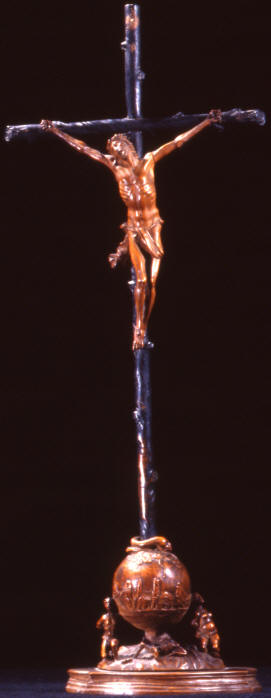
“Crucifixion
Group”
Anonymous – c. 1700 – Boxwood
This theme of Christ’s triumph is also found in this simple but
beautiful German wooden crucifix from the 1700’s. At the base of the cross are
three symbolic elements: s snake, a globe, male and female human figures, and a
skeleton. This symbolizes Christ’s triumph over the four great spiritual
enemies of humanity: the devil, represented by the snake; the world, represented
by the globe; our sinful flesh, represented by the human figures; and the
ultimate triumph, over death itself, represented by the skeleton.
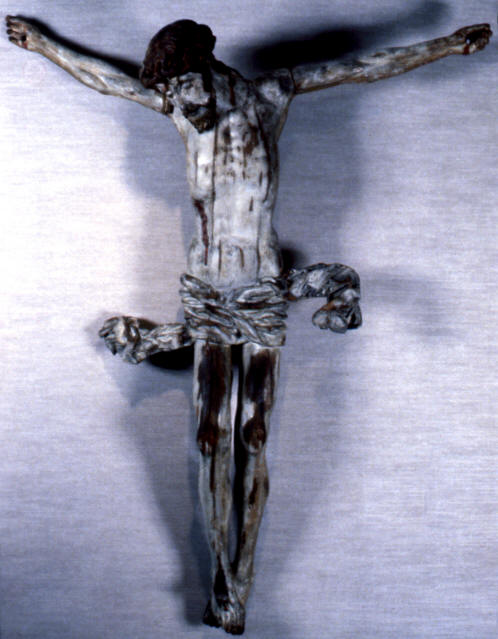
“Corpus Christi”
Anonymous – German – 1500’s – Wood
This German sculpture of Christ on the cross from the 1500’s is
certainly one of the most dramatic works on view at the Spencer Museum in
Lawrence. It is an enormous figure, close to life-size. It is very
effectively displayed and dramatically lighted at the end of a long museum
gallery. It really gives you the feeling of being in a church, with this
figure as it was originally displayed, mounted on a cross above an altar.
On Good Friday our Lord Jesus was unjustly condemned, brutally tortured, and finally put to death—the Son of God crucified. He hung on the cross in agonizing torture from the third hour to the ninth hour, from 9:00am to 3:00pm. So, by this time of day on the first Good Friday, “The Descent from the Cross” was finished and Jesus lay in the tomb. The only good person who ever lived was dead and gone. Yet we call that day “Good” Friday, because he was crucified, dead, and buried for OUR good.

Detail from “Descent from the Cross”
Triptych
Workshop of the Master of Frankfurt – 1500’s – Oil on Oak Panels
At the base of the cross in this triptych is a symbol we still use
today: the skull and crossbones. In many old artworks this universal
symbol of death is placed at the base of the cross, not as a warning but as a
promise. As Paul says in 2nd Timothy, “Our Savior Jesus Christ has
destroyed death and has brought life and immortality to light through the
Gospel.” Hebrews puts it this way, “By his death he destroyed him who
holds the power of death—that is, the Devil—and freed those who all their
lives were held in slavery by their fear of death.” Paul says in 1st
Corinthians, “Where, O death, is your victory? Where, O death, is your sting? .
. . Thanks be to God! He gives us the victory through our Lord Jesus Christ.”
Just after the Fall into sin, on the very first pages of the Bible in
Genesis, the Lord promised that one day the Savior would crush Satan. You
might think in this picture that Jesus is the one who was crushed and defeated.
But, it’s really that skull and crossbones which is lying in defeat at the base
of the cross, to symbolize that on Good Friday it was not Jesus who was crushed
and defeated, but Satan, sin, and death itself. As Paul says in Colossians, “He
disarmed the powers and authorities . . . triumphing over them by the cross.”
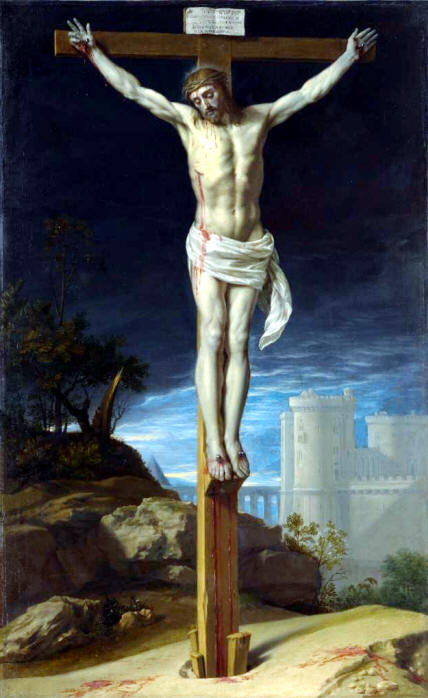
“Christ’s Death on the Cross”
Philippe de Champaigne – French – 1655
Our final artwork in this sermon series is a French painting from 1600’s
on display at the Nelson-Atkins Museum, which movingly portrays “Christ’s Death on
the Cross.” That’s what it’s really all about. The cross is the most
recognized symbol of the Christian faith because that image, that event, that
doctrine—Christ’s death on the cross—is the center of our faith. As
the Apostle Paul declares: “We preach Christ crucified . . . For I resolved to
know nothing while I was among you except Jesus Christ and him crucified. . .
Woe to me if I do not preach this Gospel! . . . May I never boast except in the
cross of our Lord Jesus Christ.”
Return to Top | Return to Sermons | Home | Email Church Office